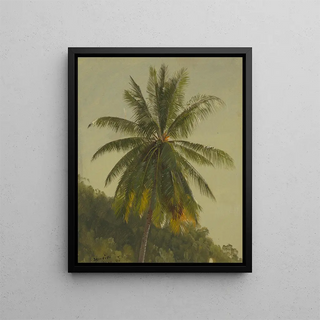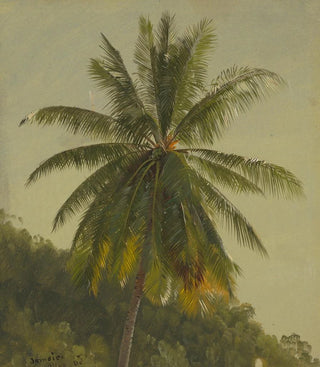Painting Palmiers Antilles - Frederic Edwin Church | Art print


View from behind

Frame (optional)
Reproduction of the Caribbean Palms - Frederic Edwin Church – Captivating introduction
In the vibrant universe of 19th-century landscape art, the artwork "Caribbean Palms" by Frederic Edwin Church stands out for its brilliance and depth. This canvas transports us to a lush world where light and color intertwine to capture the very essence of the tropics. Church, a prominent figure of the American Romantic movement, invites us to explore a nature that is both sublime and wild, revealing the beauty of exotic landscapes that fascinated his era. Contemplating this piece, the viewer is immersed in a vibrant atmosphere where every detail seems to whisper the secrets of the Antilles.
Style and uniqueness of the work
The uniqueness of "Caribbean Palms" lies in Church's exceptional mastery of light and composition. The artwork unfolds before our eyes like a living painting, where majestic palms rise against a fiery sky, tinged with warm and enchanting hues. Church excels in depicting textures, making the lush foliage and dancing shadows on the ground almost tangible. His bold palette, blending deep greens with shimmering golds, creates a visual harmony that evokes the warmth and exoticism of the islands. Each brushstroke appears charged with emotion, bearing witness to an intimate connection between the artist and the nature he immortalizes. This piece, through its unique style, reminds us of art's ability to transcend time and space, allowing us to feel the magic of the Antilles through the lens of imagination.
The artist and his influence
Frederic Edwin Church, born in 1826, is one of the leading representatives of the Hudson River School, an artistic movement that values the grandeur of American landscapes. Influenced by his travels in South America and the Caribbean, Church managed to incorporate elements of these cultures into his creations. His innovative approach and fascination with light marked a crucial step in the evolution of landscape art. As an engaged artist, Church also used his art to raise awareness of natural beauty and the need for their preservation. "Caribbean Palms" reflects this quest to

Matte finish

View from behind

Frame (optional)
Reproduction of the Caribbean Palms - Frederic Edwin Church – Captivating introduction
In the vibrant universe of 19th-century landscape art, the artwork "Caribbean Palms" by Frederic Edwin Church stands out for its brilliance and depth. This canvas transports us to a lush world where light and color intertwine to capture the very essence of the tropics. Church, a prominent figure of the American Romantic movement, invites us to explore a nature that is both sublime and wild, revealing the beauty of exotic landscapes that fascinated his era. Contemplating this piece, the viewer is immersed in a vibrant atmosphere where every detail seems to whisper the secrets of the Antilles.
Style and uniqueness of the work
The uniqueness of "Caribbean Palms" lies in Church's exceptional mastery of light and composition. The artwork unfolds before our eyes like a living painting, where majestic palms rise against a fiery sky, tinged with warm and enchanting hues. Church excels in depicting textures, making the lush foliage and dancing shadows on the ground almost tangible. His bold palette, blending deep greens with shimmering golds, creates a visual harmony that evokes the warmth and exoticism of the islands. Each brushstroke appears charged with emotion, bearing witness to an intimate connection between the artist and the nature he immortalizes. This piece, through its unique style, reminds us of art's ability to transcend time and space, allowing us to feel the magic of the Antilles through the lens of imagination.
The artist and his influence
Frederic Edwin Church, born in 1826, is one of the leading representatives of the Hudson River School, an artistic movement that values the grandeur of American landscapes. Influenced by his travels in South America and the Caribbean, Church managed to incorporate elements of these cultures into his creations. His innovative approach and fascination with light marked a crucial step in the evolution of landscape art. As an engaged artist, Church also used his art to raise awareness of natural beauty and the need for their preservation. "Caribbean Palms" reflects this quest to
12,34 €






